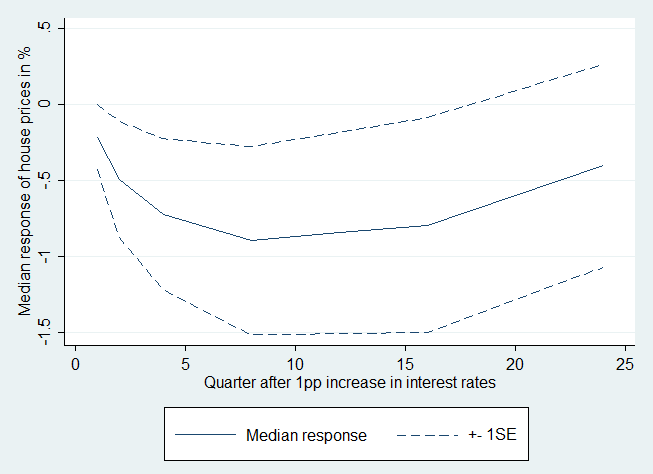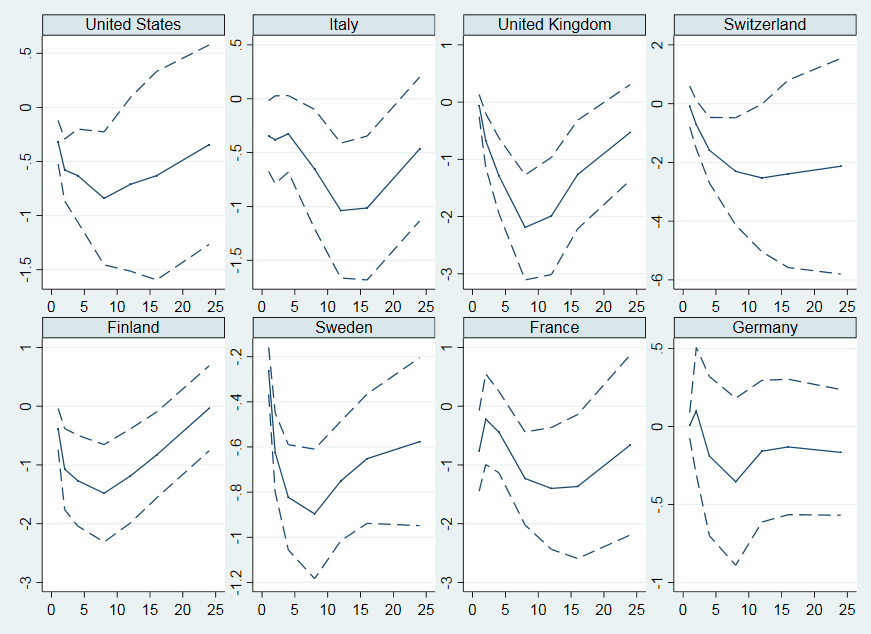Monetary Policy and House Prices – How Strong is the Transmission?
The effect of changes in monetary policy interest rates on house prices has been a centre of attention in many economic and policy debates, as well as in an extensive academic literature. While the direction of the effect of a change in rates is more or less clear from both the theoretical and empirical perspective, the estimated magnitude of the effect differs from study to study, sometimes significantly. Thus, in our research paper The effect of monetary policy on house prices – how strong is the transmission? we focus on this relationship and aim to examine the true effect by means of a quantitative survey of the available literature (a meta-analysis). The aim of meta-analysis is to estimate the average effect reported in the literature, adjust it for potential publication bias and explain any differences.
Published in the CNB WP 14/2020 (pdf, 1,2 MB)
We offer the first systematic survey of the literature examining the effect of a change in policy interest rates on house prices. While the effect of monetary policy on consumer prices has been studied in a large number of primary studies and in meta-analyses (Rusnak et al., 2013; Havranek & Rusnak, 2013), a synthesis of the effect on house prices has been missing. In our paper, we present more than 1,400 estimates of the effect of policy interest rates on house prices over various time horizons. We thus explore not only the short-term impact of a change in rates, but also the medium and long-term effect. The estimates come from 31 international studies covering 27 countries. Our aim is to provide the most comprehensive possible synthesis of the literature, i.e. to cover as many studies as possible, but to keep the estimates directly comparable. The summary of the results of primary studies shows that an increase in the policy rate by one percentage point leads to a decline in house prices of 0.7% after one year and 0.9% after two years on average (Figure 1).
Figure 1: Summary of all estimates available in the literature

Note: The graph shows the median impulse response implied by the literature: the effect of a 1 pp increase in the policy rate on house prices (y-axis) over various time horizons (x-axis).
In order to reveal the true magnitude of the effect, we need to examine the possible publication bias. It occurs when different estimates have different probabilities of being reported, based on their direction, size or statistical significance. To put it differently, large and statistically significant estimates or estimates with the “correct” sign may be preferentially selected for publication. As a result, publication bias – a bias in the average estimate towards a stronger effect – emerges. In order to examine potential publication bias we use graphical and simple linear methods as well as more complex nonlinear models (see, for example, Furukawa, 2019, and Andrews & Kasy, 2019). All approaches lead to similar results: positive and statistically insignificant results are systematically underreported in the literature. After adjusting for this publication bias, the effect of a change in interest rates on house prices at each time horizon is rather weaker than the median effect shown in Figure 1. The effect at the monetary policy horizon, i.e. 12–18 months after the change in interest rates, however, remains statistically significant even after adjustment for this bias.
We observe significant differences in the estimates for individual countries in the literature (Figure 2). The differences may be due to the structural characteristics of the economies in question (Calza et al., 2013; Iacoviello & Minetti, 2008), but also to differences in the methodological approaches used to estimate the effect. Therefore, we extend our dataset of 1,400 estimates with more than 40 other variables that help us explain these differences. The additional variables can be divided into several areas: (i) data characteristics (for example, data frequency and time period) and model and estimation specification, (ii) publication characteristics (for example, journal quality or number of citations) and (iii) country-level macroeconomic, financial and demographic variables.
Figure 2: Differences in published estimates across countries

The most important drivers of the heterogeneity in the estimates are model specification and structural characteristics of economies. For example, the results differ systematically if a long-term interest rate is included in a model. Of the structural country-level characteristics, the level of indebtedness and whether house prices have long been overvalued seem to be the most important factors. After taking into account these data and method choices, the average decrease of house prices in response to an increase in interest rates of one percentage point attains values of 0.9% to 2.7%, depending on country. The effect is thus even slightly stronger than the one in the primary studies. The effect of publication bias remains significant after we control for all other variables. The effect is the strongest at the end of the medium-term horizon (i.e. after eight quarters).
The effect of a change in policy rates on house prices is stronger than the effect on consumer prices or real economic output. This is a key result of our study and is in line with the existing literature. The fact that the impact of policy rates on house prices is stronger than the effect on consumer prices and real output was already mentioned in Coibion et al. (2013) and Assenmacher-Wesche & Gerlach (2010). For example, an extensive meta-analysis of the effect of policy rates on the consumer price level (Rusnak et al., 2013) asserts that the maximum decrease in the consumer price level after an increase in interest rates of one percentage point is around 0.33%, i.e. markedly lower than the effect estimated by us for house prices. The true direction and the magnitude of the effect of monetary policy on house prices is important for understanding monetary policy transmission, its effect on financial stability and the interaction with prudential policies. This may be particularly crucial in times of high house price growth accompanied by a growing level of indebtedness.
References
ANDREWS, I. & M. KASY (2019): “Identification of and correction for publication bias.” American Economic Review, 109(8):2766–2794.
ASSENMACHER-WESCHE, K. & S. GERLACH (2010): “Monetary policy and financial imbalances: Facts and fiction.” Economic Policy, 25(63):437–482.
CALZA, A., T. MONACELLI, & L. STRACCA (2013): “Housing finance and monetary policy.” Journal of the European Economic Association, 11(1):101–122.
COIBION, O., Y. GORODNICHENKO, L. KUENG, & J. SILVIA (2017): “Innocent bystanders? Monetary policy and inequality.” Journal of Monetary Economics, 88:70–89.
FURUKAWA, C. (2019): “Publication bias under aggregation frictions: Theory, evidence, and a new correction method.” ZBW-Leibniz Information Centre for Economics.
IACOVIELLO, M. & R. MINETTI (2008): “The credit channel of monetary policy: Evidence from the housing market.” Journal of Macroeconomics, 30(1):69–96.
HAVRANEK, T. & M. RUSNAK (2013): “Transmission lags of monetary policy: A meta-analysis.” International Journal of Central Banking, 9(4):39–76.
RUSNAK, M., T. HAVRANEK, & R. HORVATH (2013): “How to solve the price puzzle? A meta-analysis.” Journal of Money, Credit and Banking, 45(1):37–70.